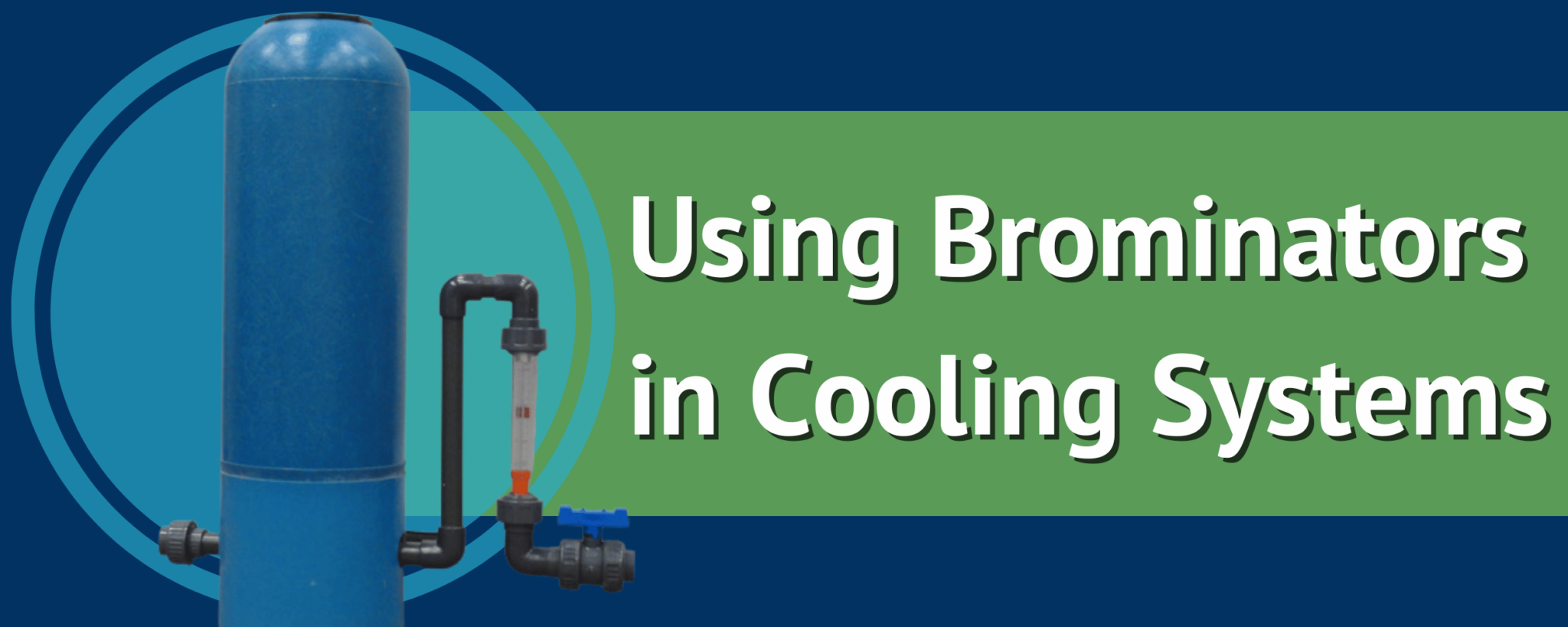
Brominators treat organic contaminants in cooling water systems by releasing a biocide called bromine. They are typically smaller than the alternative batch tank and chemical pump setup and are easier to install. The way it works is by untreated water passing through it and having bromine biocide released into it. In a brominator, bromine can come in a tablet or liquid form. Either can be released faster or slower by adjusting the water flow. This is done with a timer or controller solenoid valve. Brominators are utilized in cooling towers, closed loops, chillers, fluid coolers, condensers, and other cooling water systems.
Although they are both oxidizing biocides, bromine and chlorine do differ in effectiveness and cost. They are often mixed with other common water treatment chemicals and tablets. There are a few useful tests to measure the two biocides’ effectiveness. The best test is to measure the free halogen residual. It shows the concentration of unreacted bromine/chlorine which still can kill organic life in your water. Any less of a concentration than the halogen residual amount will not be effective at killing microorganisms.
In recent years, cooling towers and other cooling systems have been operating at a higher pH. When it is over 8pH bromine will kill organic organisms faster than chlorine will. In high-alkalinity water situations, bromine is more effective than chlorine as a biocide. Additionally, when there are higher levels of ammonia in the water, bromine will be more effective than chlorine.
Chlorine has been traditionally used as a disinfectant for cooling water systems. It is inexpensive in comparison to alternative oxidizing biocides like bromine. Chlorine is sufficient for many applications and is still an effective way to combat organic contaminants. It is important to consider whether bromine’s benefits are worth its additional costs from chlorine.
BCDMH, Sodium Bromide, and other chemicals combine bromine and chlorine, utilizing the beneficial properties of each chemical. Bromine will rarely be used by itself, on the other hand, chlorine is often used without bromine for cooling water systems. When it comes to costs, BCDMH is the most expensive, followed by sodium bromide, and sodium hypochlorite (bleach). Please note that brominators and feeders for chlorine are referred to by several names. This name could be brominator, chemical feeder, chlorine feeder, bromine feeder, biocide feeder, or chlorinator.
The type of brominator for your fluid cooler, cooling tower, or cooling system should be a brominator model that can withstand high pressure. Low-pressure brominators are commonly used for swimming pools and are likely not sufficient for the flow rate of your cooling system. High-pressure brominators are typically useful for commercial, and industrial needs, while low-pressure brominators are useful for residential needs.
Controlling microbiological growth in fluid coolers, evaporative condensers, and forced draft cooling towers requires special considerations. Since this type of cooling tower is self-contained, it is often located away from other buildings. This makes the installation of traditional batch tanks and chemical pumps more complex since they must be insulated from freezing and ultraviolet deterioration. Additionally, the potential to overfeed biocide is distinct since the volume of water in these systems is typically quite low.
The small brominator shown in the photo above provides a cost-effective solution to both problems. The unit is self-draining and resistant to freezing since it is mounted above the water line in the tower sump. If freezing becomes an issue, refer to the Chardon Modification below. This installation method is also flow-sensitive since the input for the brominator comes directly from the spray pump. When the pump is off, there is no flow through the brominator even if the solenoid valve is open.
This Chardon modification tip involves the addition of a check valve to allow the entire assembly to drain when not in use. The top side intake of the Brominator is commonly plumbed to a hot tap high on the tower spray pump pipe. You will want a solenoid valve that is threaded onto the saddle fitting for support, a brand we recommend for this is Sandy Well. It is important to include a downward grade between the solenoid valve and the intake of the Brominator as shown in the illustration above. To further ensure that the piping and Brominator vessel drain when not in use, check the downstream side of the solenoid valve with a check valve mounted such that air can enter the pipe, but water cannot escape.
Need help with your equipment installation, operation, efficiency optimization, troubleshooting, or replacement? Turn to the water treatment experts at Chardon Labs. To see if this offer is available in your area, review our available service locations. Get in touch with us by completing a contact form or by calling us at (380) 224-7395.